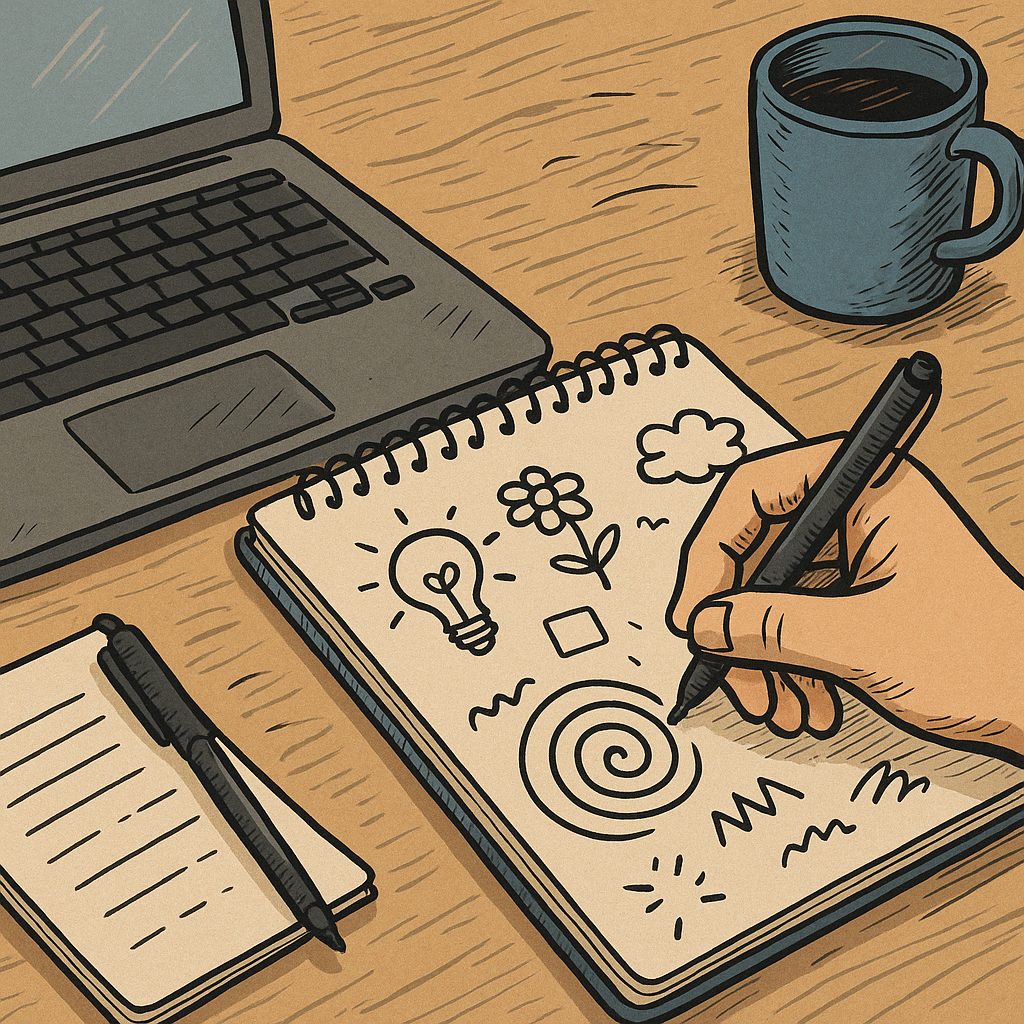Doodling is emerging as a real doodling productivity hack that can sharpen focus, spark creativity, and improve memory. In this guide, you’ll learn how simple sketches can help you stay alert, think clearer, and get more done—even during tedious meetings or long study sessions.

How Doodling Keeps You Focused
One of the most compelling reasons doodling boosts productivity is its effect on attention. In 2009, Jackie Andrade at the University of Plymouth had participants listen to a monotonous, 2.5-minute phone message. While half doodled (simply shading shapes), the rest sat quietly—and the doodlers scored 29% higher in recall tests.
Researchers concluded that doodling helps the mind “stay online”: it uses just enough cognitive energy to block drifting into daydreams but leaves the brain free to absorb the primary task. In other words, doodling prevents the brain from slipping into its “default mode,” keeping your mind anchored.
This isn’t just isolated research. Harvard Health reports that a 30-minute doodle session supports memory retention, thinking clarity, and provides a cognitive break during information overload.
Within this context, the idea of a doodling productivity hack starts to make sense: by softly engaging your motor skills, doodling keeps attention and turns a distracting habit into a productivity tool.
Doodling’s Impact on Memory & Information Retention
The link between doodling and memory goes beyond anecdotal evidence. In the same University of Plymouth experiment, participants who doodled remembered around 7.5 details of the message—compared to 5.8 by non-doodlers.
It’s not just about shading shapes. A 2023 Applied Cognitive Psychology study showed that drawing information improves memory; the act of visually encoding ideas and motor tracing creates richer mental connections than passive listening.
That’s why doodling during meetings, lectures, or brainstorming can help you remember key facts—even if it looks like you’re not paying attention.
The Creativity & Problem-Solving Boost
Doodling isn’t only useful for memory—it also helps with creative thinking and problem-solving. Sunni Brown, author of The Doodle Revolution, explains that free-form drawing engages brain networks that support visual thinking and ideation.
Historically, great thinkers like Einstein, da Vinci, Rowling, and many U.S. presidents used doodling to develop ideas visually . In modern contexts, Drexel University-led studies show that doodling, coloring, or sketching activates the brain’s reward pathways—specifically the prefrontal cortex—triggering motivation and creative insight .
For a factual example, Dr. Girija Kaimal’s team measured increased blood flow in participants while doodling, more so than during coloring or free drawing.
Putting it all together, doodling isn’t frivolous—it’s a mental hack that can help solve problems or refine ideas by activating different parts of your brain.
Stress Relief and Mental Well-Being
A lesser-discussed benefit of doodling is stress reduction. Repetitive patterns—like circles, waves, or mandalas—promote relaxation and can calm the amygdala, the brain’s stress hub canva.com.
Drexel’s research observed that 75% of participants experienced lowered cortisol levels after simple art-making activities . In workplaces with chronic stress, promoting doodling as a quick calming exercise may reduce burnout and boost morale .
Incorporating doodling breaks into your routine is a proven micro-strategy to help reset focus and ease tension.
A Practical Guide: Use Doodling as a Productivity Hack
If you’re ready to try DIY productivity boosting with doodles, here’s how:
1. Choose Your Tools
Keep a pen and notepad accessible at your desk, in meetings, or near study materials. Don’t worry about how it looks—it’s the process that matters.
2. Use “Just Enough” Doodling
Put your hand on autopilot:
- Shade shapes or spirals
- Trace continuous lines (like Christine Selby’s “surf doodle” technique)
- Add simple icons related to the topic (e.g., bullet points, arrows).
Aim for light engagement—enough to prevent daydreaming, but not so intense that you ignore the task.
3. Combine Doodling with Note-Taking
Try sketch-noting:
- Draw simple shapes to track speakers or highlight takeaways
- Use visual connectors (arrows, boxes) to map relationships
- Write key words next to doodles
This integrates visual encoding with memory—studies show drawing info improves retention more than writing alone.
4. Schedule Short Doodle Breaks
During long work blocks, a 3–5 minute doodle break can:
- Reset focus
- Lower stress
- Spark creativity
It’s an evidence-based equivalent of a micro-pause—supported by neuroscience .
5. Reflect on Your Doodles
After sessions, quickly review your doodles:
- Do they spark new ideas?
- Do they visually summarize points?
- Did they help you stay tuned in?
This reflection helps reinforce learning and creative thinking.
When Doodling Might Not Help
Although doodling is broadly beneficial, it may not always help when tasks require deep analytical thought or precise encoding (e.g., coding, math proofs). A 2019 study showed free-form doodling can reduce free recall compared to purposeful drawing or writing, especially in tasks with high cognitive load.
Tip: Use a lighter, structured style (simple shapes or passive tracing) when you need to stay alert without sacrificing mental bandwidth.
Why Doodling Is a Smart Hack for Modern Work
Here’s a summary of how doodling productivity hack works in today’s fast-paced environments:
- Attention anchor: Prevents zoning out with minimal cognitive cost
- Memory enhancer: Creates visual–motor links for better recall
- Creative spark: Activates reward centers and supports idea flow
- Stress buster: Helps relax the mind and maintain focus
- Practical & accessible: Requires only pen and paper—no app necessary
Final Thoughts
Doodling isn’t just for kids—it’s a science-backed way to stay engaged, enhance memory, unlock creativity, and manage stress. As a doodling productivity hack, it’s a smart, low-cost tool anyone can use:
- Keep it light—just enough to stay alert
- Use visuals next to notes for better encoding
- Take micro-doodle breaks to reset mental energy
- Reflect on your doodles—they may spark new insights
References
- Andrade, J. (2009). Applied Cognitive Psychology. Doodling improves retention by ~29%.
- Harvard Health. (2016). The thinking benefits of doodling.
- Kaimal, G. et al. (2021). Drexel University study on drawing and reward pathways.
- PubMed. (2019). Comparing doodling, drawing, writing and memory performance.
- Drexel University. (2017). Drawing and stress/mood boosts.
- Default mode network and cognitive load discussions.






